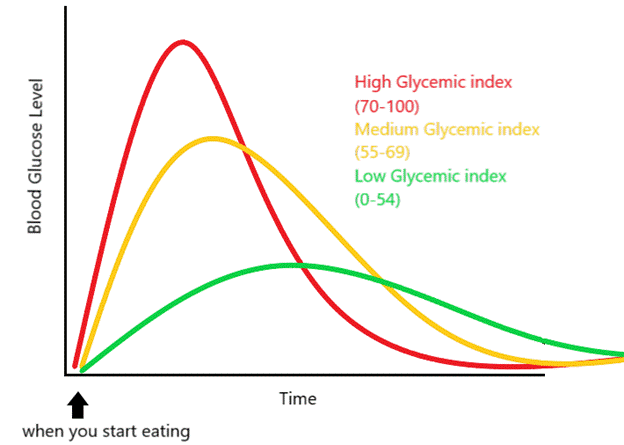<< Back to Smart Carbs
The glycemic index (GI) is a scale, ranging from 0 and 100. Foods with a higher GI number are digested and absorbed faster and lead to higher blood sugar values.
It is best to pick foods with lower GI values.
Lower means under 55.
High means over 70.
Sometimes different groups come up with different GI numbers. There are some examples below.

Low GI food (0-54)
Recommended
Breads:
Heavy Mixed Grain Breads
Whole grain
Tortilla
Pumpernickel bread
Cereal & Grains:
Oats (Steel Cut)
Oat Bran
All-Bran Original
Rice (Converted, Parboiled)
Barley
Buckwheat
Kasha
Bulgar
Quinoa
Milk products:
Yoghurt
Milk
Soy milk
Plant-based proteins:
Sweet potato/yam
Chickpeas
Kidney beans
Soy beans (Edamame)
Baked beans
Lentils
Fruits:
Apple
Banana
Grapefruit
Kiwi fruit
Orange
Peach
Pear
Medium GI food (55-69)
Recommended
Breads:
Whole grain bread
Rye bread
Pita bread
Cereal & Grains:
Cream of wheat
Instant Oats
Puffed Wheat
Basmati Rice
Brown Rice
Cornmeal
Couscous
Vegetables:
Corn
Popcorn
Fruits:
Sultanas raisins
Raw and canned apricots
Mango
Paw paw
Pineapple
Rockmelon
Other foods:
Honey
High GI food (70-100)
Not Recommended
Breads:
Kaiser roll
Mantou (Chinese steamed buns)
White bread
White bagel
Cereals & Grains:
Bran Flakes
Corn Flakes
Rice Krispies™
Instant Cream of wheat.
Sticky Rice
White Rice (Instant)
Millet
Milk products:
Rice milk
Vegetables:
White potatoes
Instant mashed potatoes
French fries
Fruits:
Watermelon
Banana (overripe)
Lychee
Dried dates
Other foods:
Table sugar
Corn syrup
To reduce fluctuations in your blood sugar levels, non-starchy vegetables such as leafy greens (examples: lettuce, spinach, kale and chard) and cruciferous vegetables (examples: cabbage, cauliflower, Brussel sprouts and broccoli) have low GI values and very little impact on blood sugar levels. On the other hand, some starchy vegetables like potatoes have a higher GI and this could be considered in making food choices. Remember that the starchy foods (starchy vegetables, rice, bread, etc,) should make no more than a quarter of what you eat at a meal. Pulses like beans and lentils, basmati rice and whole grains are nourishing lower GI foods, and are preferred over starchy vegetables, white rice and refined grains. On the other hand, leafy greens and cruciferous vegetables can be half of what you eat.
Fruits, depending on their types, generally have a low to medium GI rating. They are best consumed as ‘dessert’ after a meal or in combination with a protein source (link to snack information). This lowers their ‘glycemic load’ because the protein slows down digestion.
More Glycemic Index Tips
- Consume a variety of foods at every meal. Eating large amount of carbohydrates, even if low GI foods, can still make blood sugar levels too high, so you still need follow healthy plate proportion principles.
- Limit use of processed foods. More processed products usually have higher GIs.
- Avoid over-cooking: usually the more a starchy food is cooked, the more it breaks down easily into glucose, raising blood sugar more quickly.
- Pasta cooked al dente (firm) have a lower GI than soft cooked pasta
- Medium cooked carrots have lower GI than fully cooked carrots.
- Although fruits and yogurt are simple carbohydrates, when consumed as part of the meal they are digested more slowly preventing rapid spikes in your blood sugar levels.
- Make “smart” carbohydrate choices by choosing low GI foods as part of your meals and snacks to allow you to better control your blood sugar levels.
